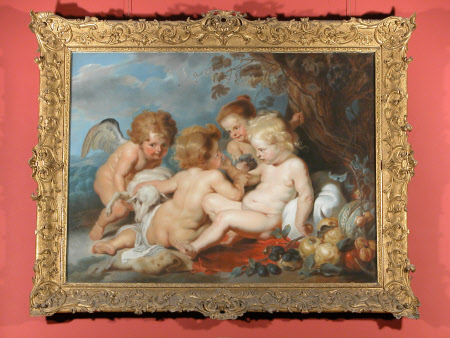The Infants Christ and John the Baptist with two Child Angels, a Lamb, and a Still-Life of Fruit (after Sir Peter Paul Rubens)
William Hoare of Bath, RA (Eye 1707 – Bath 1792)
Category
Art / Drawings and watercolours
Date
circa 1762 - 1763 (bill payment)
Materials
Pastel on paper
Measurements
940 x 1245 mm
Order this imageCollection
Stourhead, Wiltshire
NT 730786
Summary
Pastel on paper, The Infants Christ and John the Baptist with two Child Angels, a Lamb, and a Still-Life of Fruit (after Sir Peter Paul Rubens and Franz Snyders) by William Hoare of Bath, RA (Eye 1707 – Bath 1792). The Infant John the Baptist, in the foreground, hands the Christ Child a bunch of grapes; to his left, a putto-angel attempts to hold a struggling lamb; behind them, a little girl-child holds a stem of a vine; a still-life of a melon, quinces, and plums, foreground right. Rubens’s and Snyders's original, with some variations, is in the Kunsthistorisches Museum, Vienna; a panel similar to, and of the same dimensions as NT730786 was at nearby Wilton House, Wiltshire (sold at Christies, 15.4.83, lot 62. Described by Hella Robels, Frans Snyders, 1989, no.27II, p.367, as a collaboration between Snyders himself and Rubens's studio - possibly Van Dyck) which would have been the picture that was copied by William Hoare. The album of his drawings sold at Sotheby's, 11 November 1993, lot 25, contained one aux trois crayons that appeared to have been studied from the Christ Child on the right. It is curious that Henry II Hoare ‘the Magnificent’ should originally have hung this pastel in the best-lit room in the house, his pioneering top-lit picture gallery, but it illustrates his pride in it and his protégé. By the time of his death, however, he had evidently thought the better of it, and hung it in a bedroom, to which its imagery would have been appropriate (whereas, in the Sky-Light Room, it had hung along with two Venus’s by Hoare!). In keeping with his awareness of the fragility of works on paper, Colt Hoare re-hung it in the Dining Room (which would probably mostly have been lit by artificial light).
Provenance
Horace Walpole had recorded the picture as in the Sky-Light Room in July 1762; and thence by descent; given to the National Trust along with the house, its grounds, and the rest of the contents by Sir Henry Hugh Arthur Hoare, 6th Bt (1865 – 1947) in 1946
Makers and roles
William Hoare of Bath, RA (Eye 1707 – Bath 1792), artist after Studio of Sir Peter Paul Rubens (Siegen 1577 - Antwerp 1640) and Frans Snyders (Antwerp 1579 - Antwerp 1657), artist after Frans Snyders (Antwerp 1579 - Antwerp 1657), artist after Sir Peter Paul Rubens (Siegen 1577 - Antwerp 1640), artist
